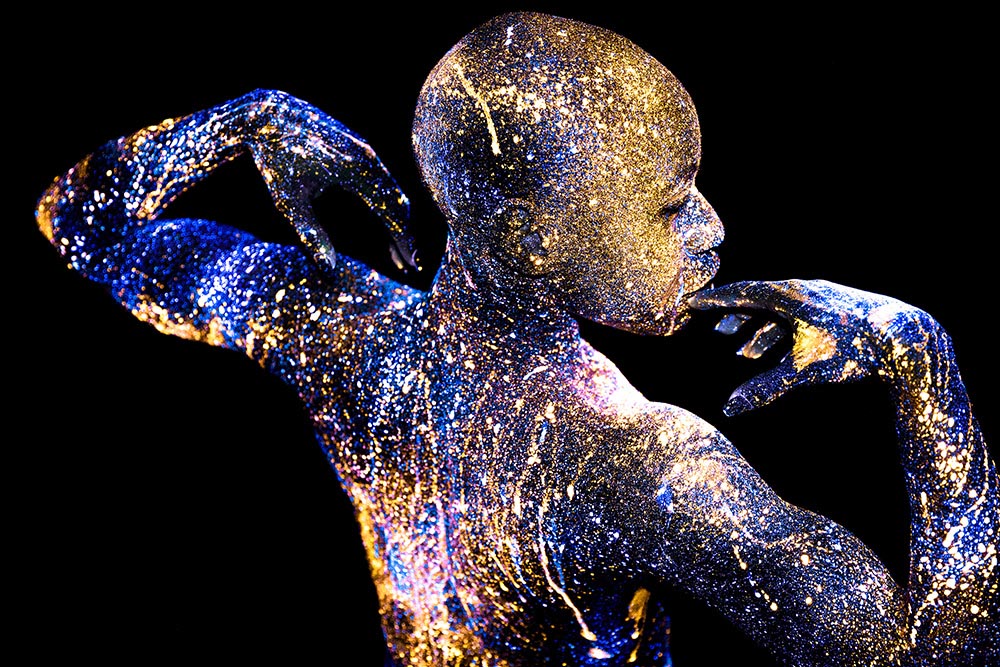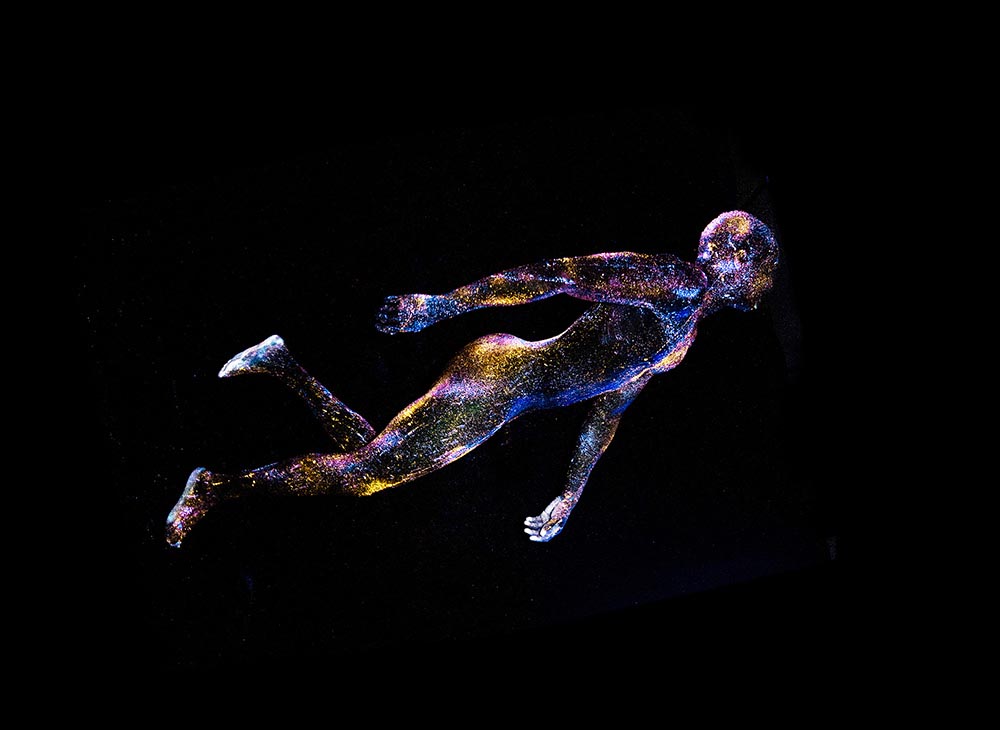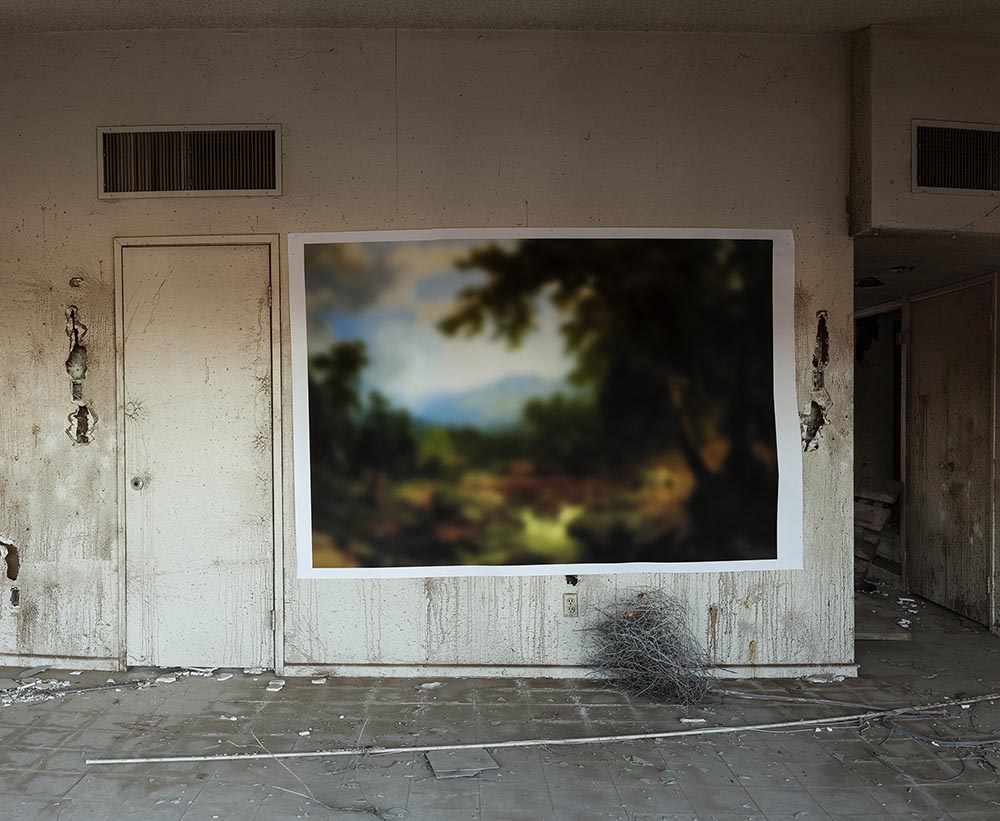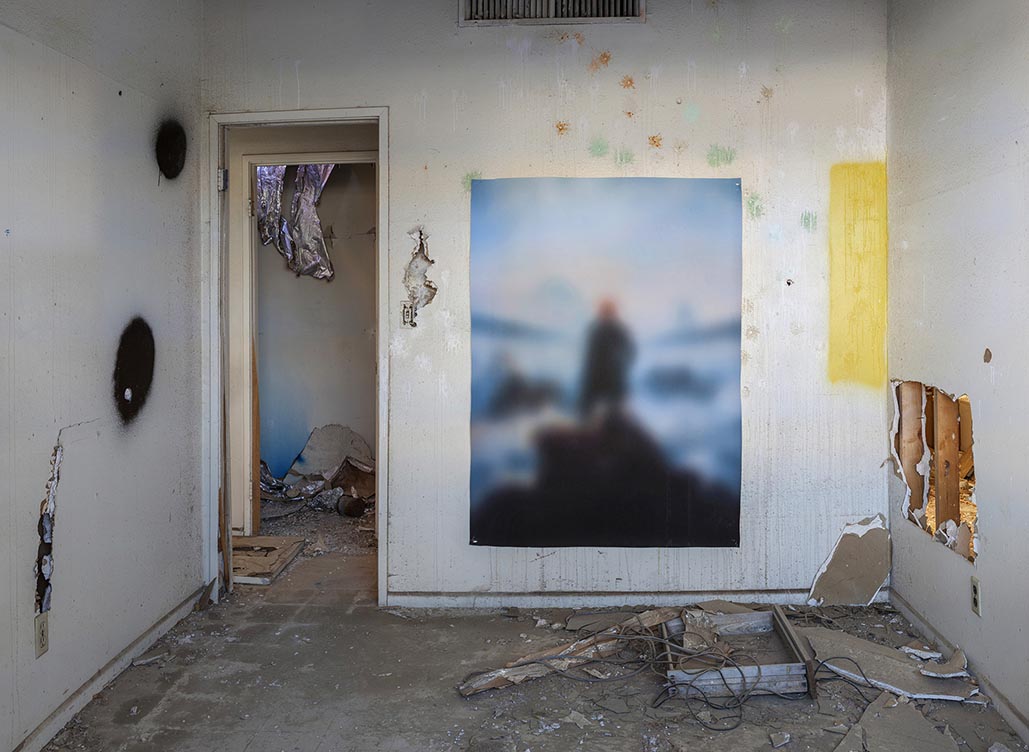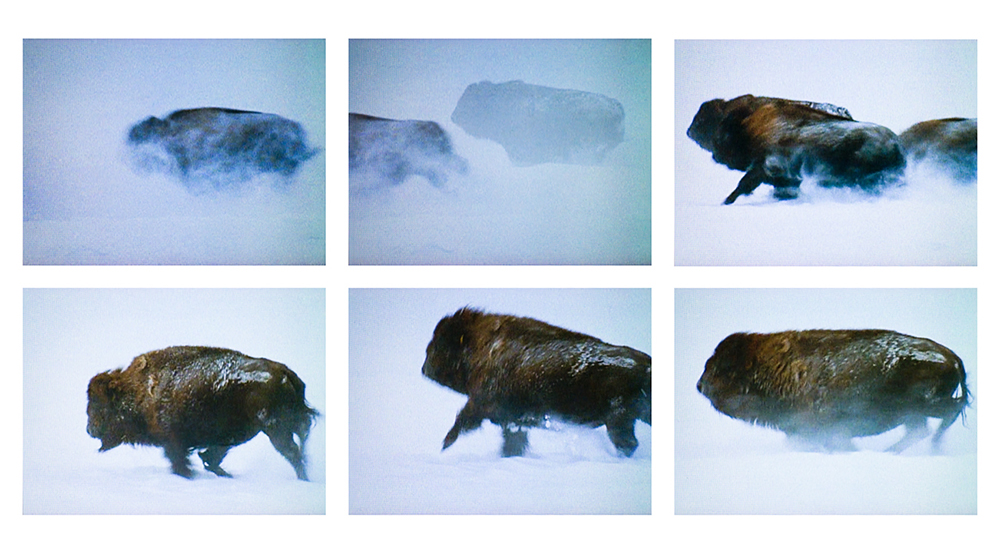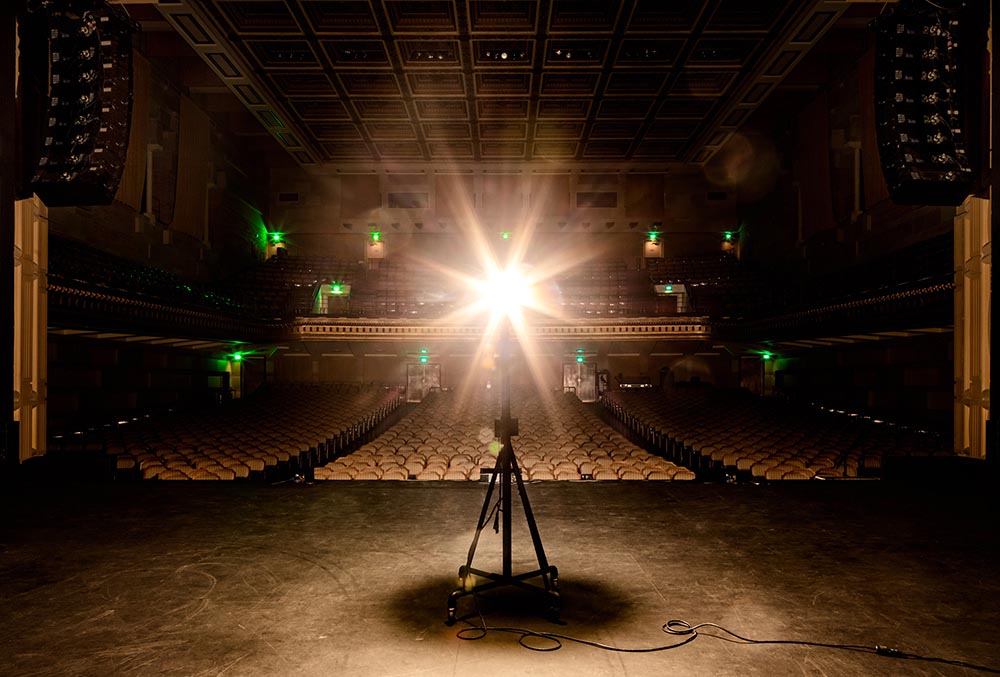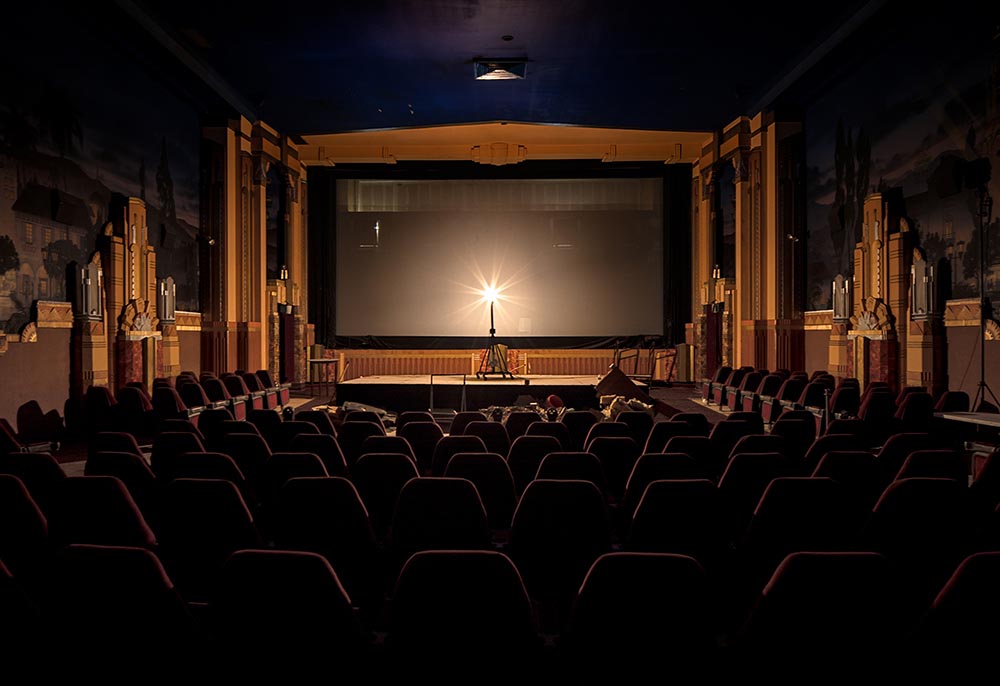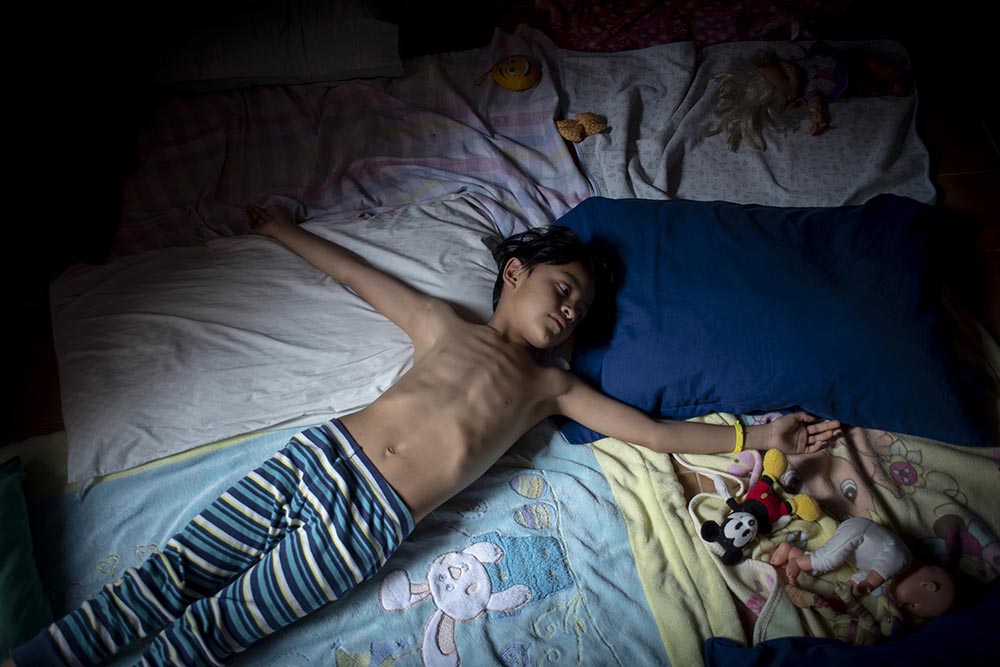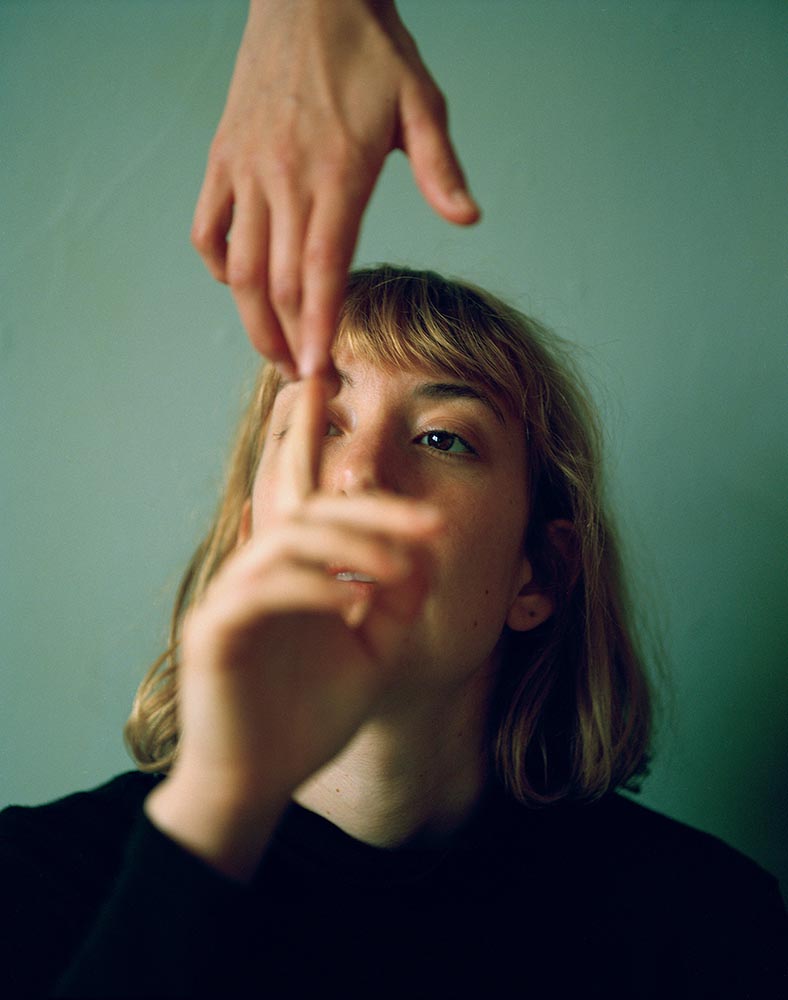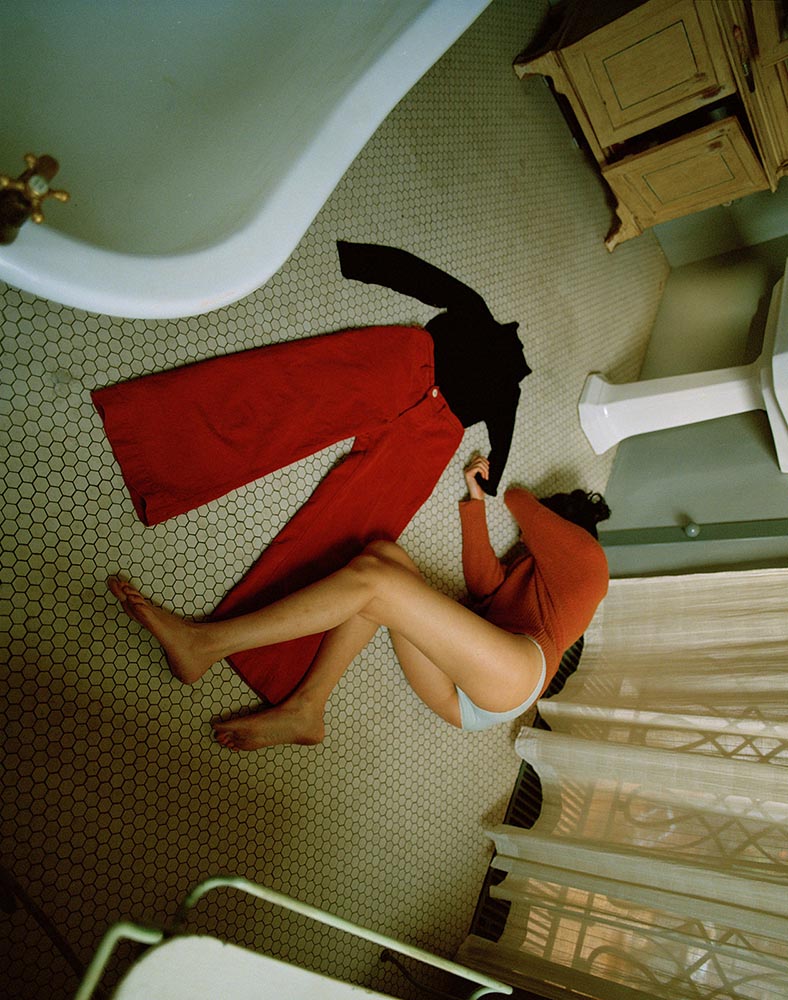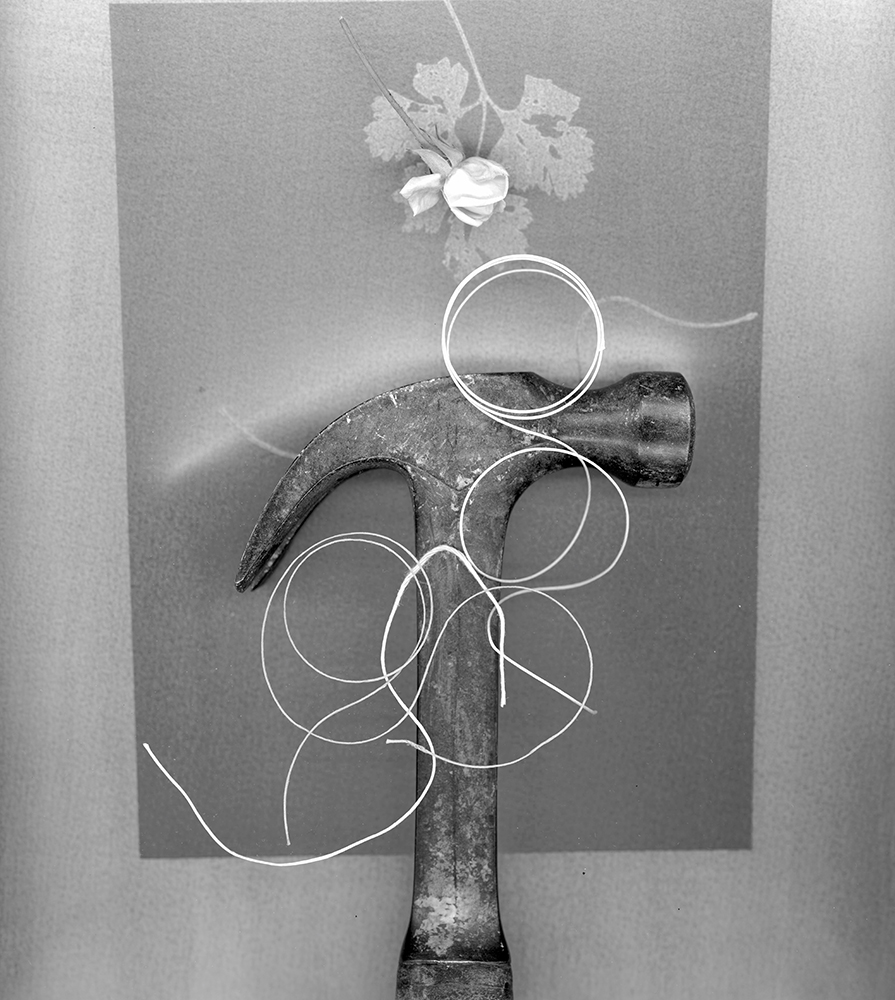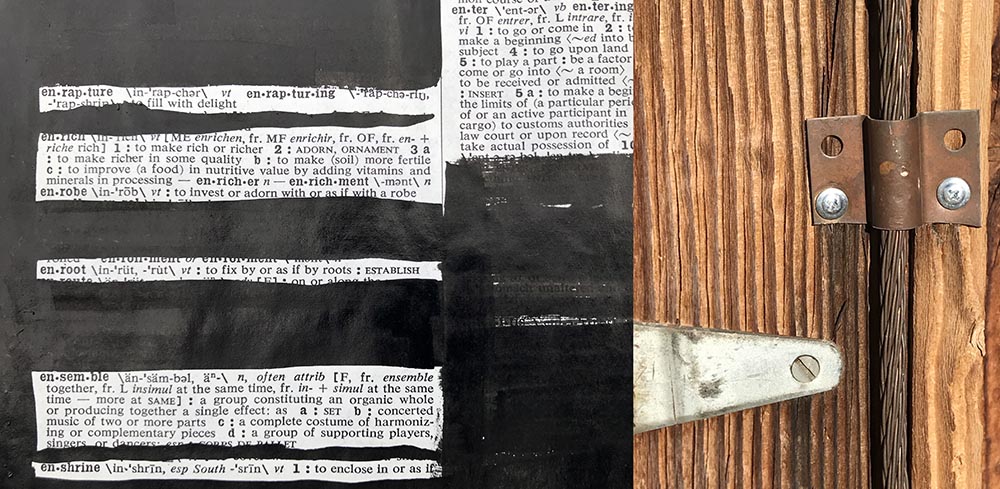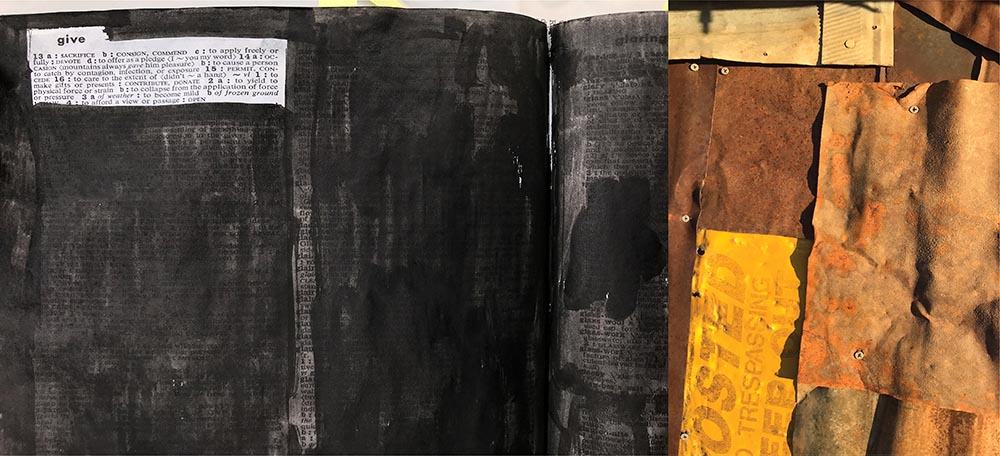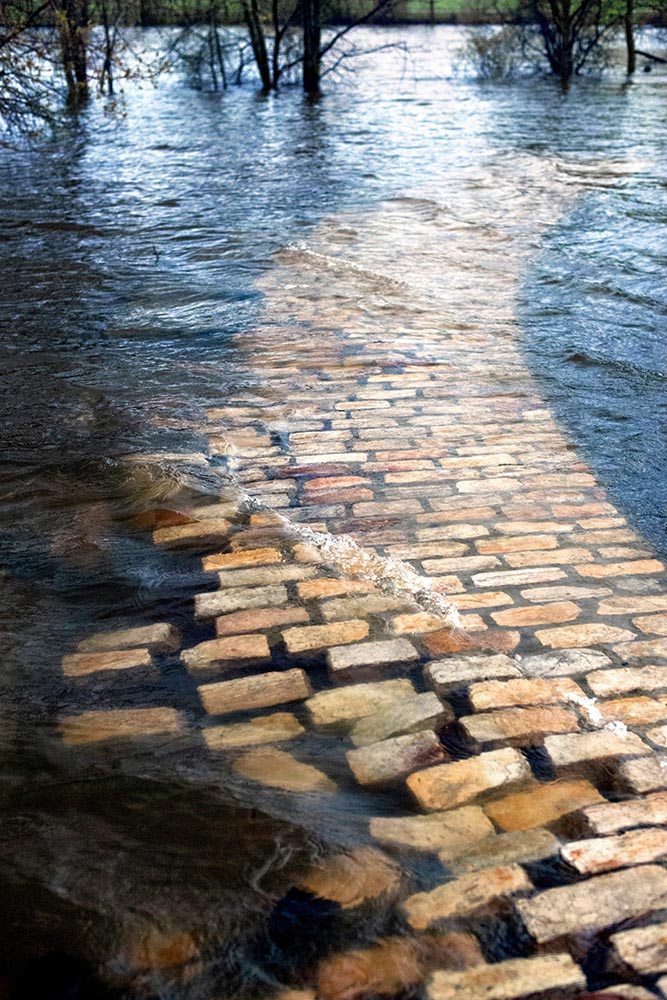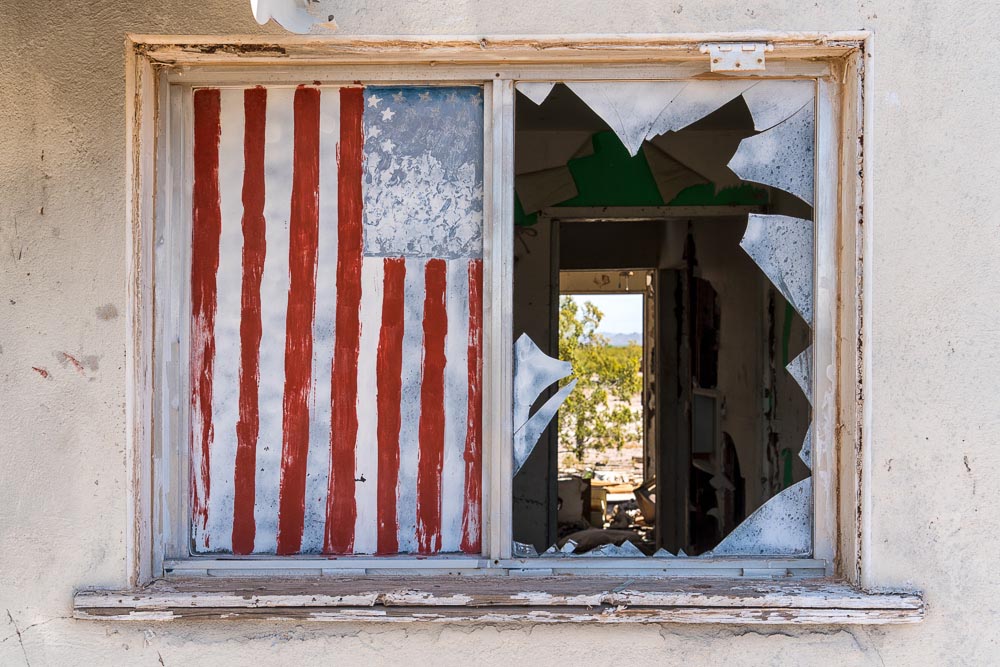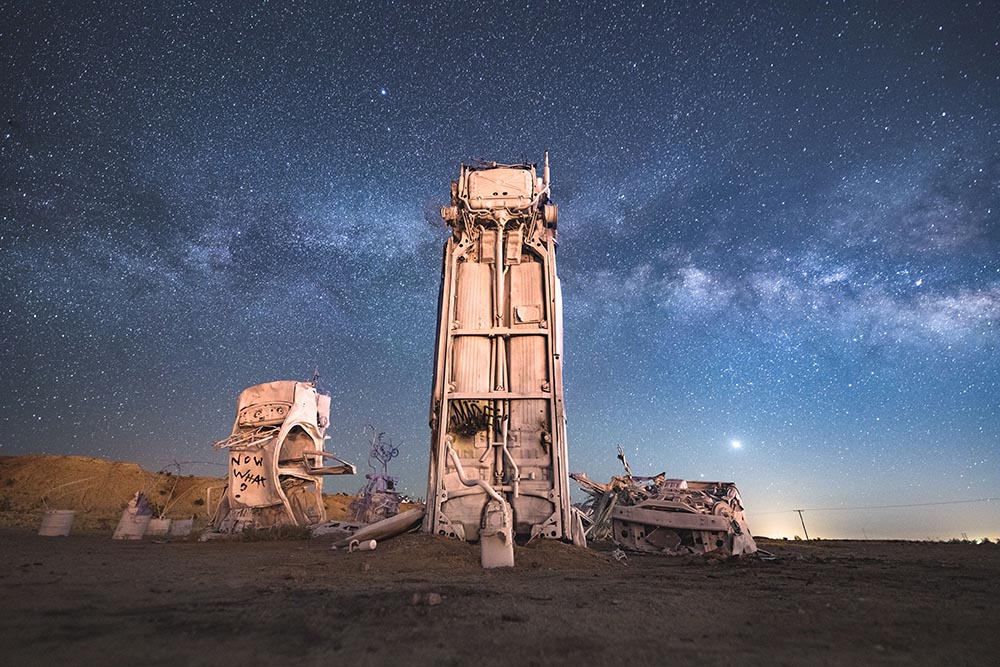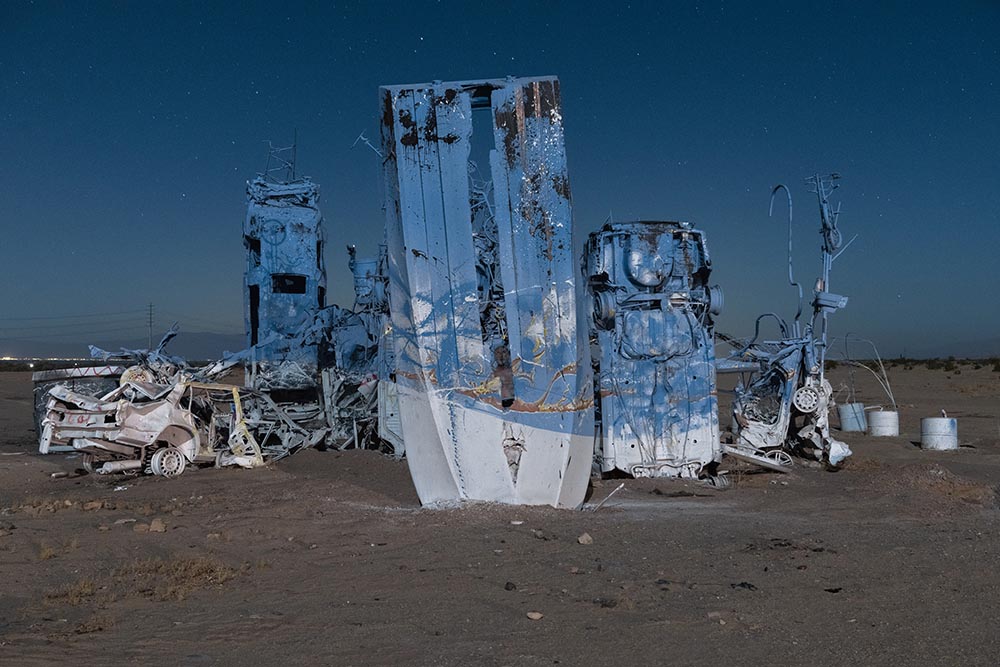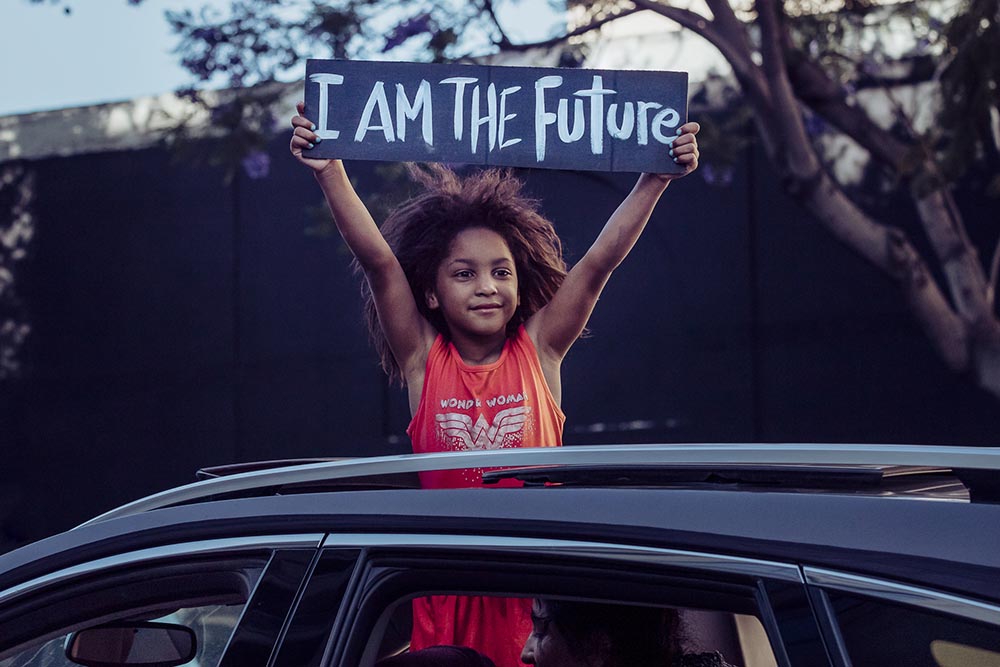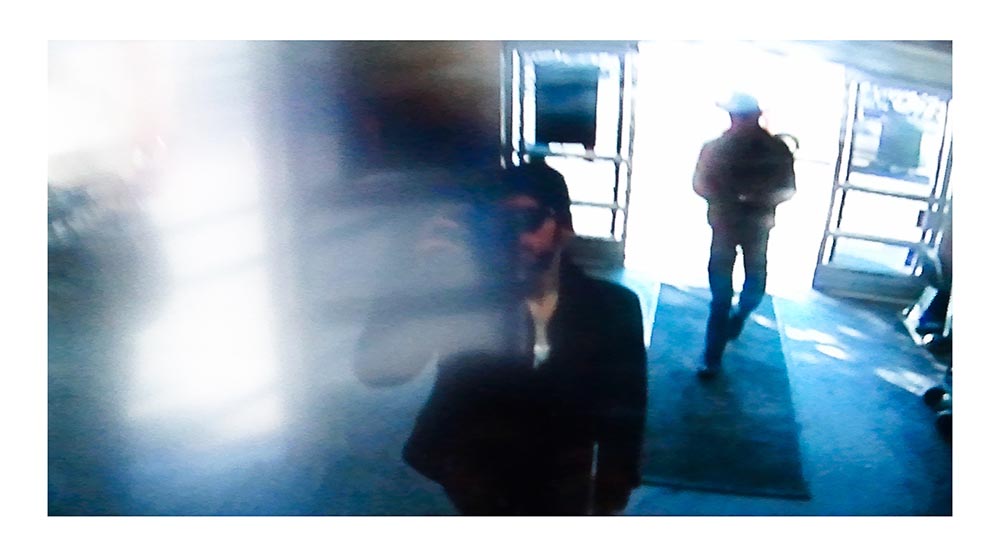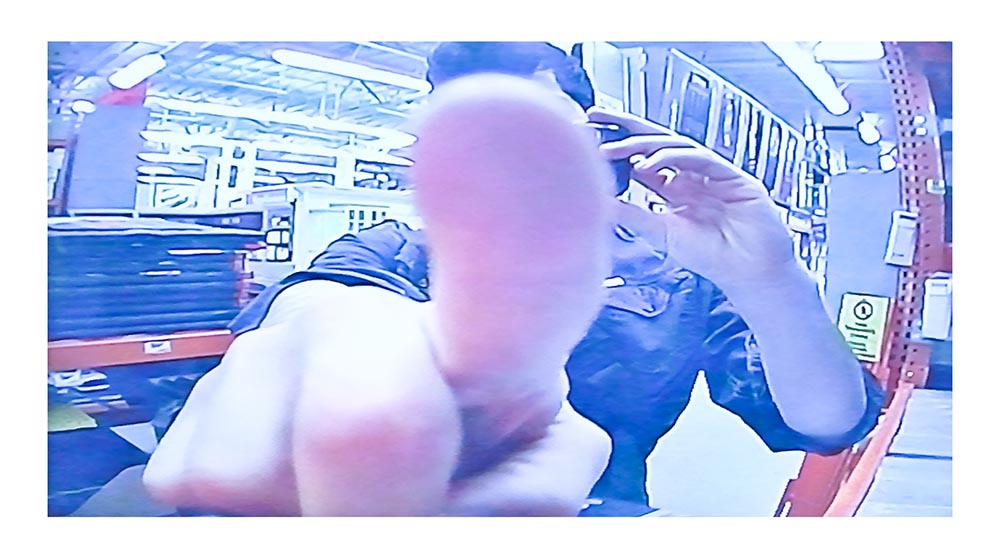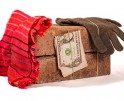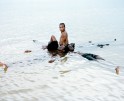Art in the Plague Year
To kick off a week of projects created during the pandemic, we start with a new online exhibition, Art in the Plague Year, organized by UCR ARTS: California Museum of Photography and curated by Douglas McCulloh, Nikolay Maslov, and Rita Sobreiro Souther.
Art in the Plague Year presents art that looks toward the future. “There is another world, but it is in this one,” said Surrealist poet Paul Éluard. In this exhibition, artists imagine how the world may be molded by the tumultuous events of the past year. History tells us that pandemics are portals to new futures. This work offers hints about means of change and pathways forward. Artists are keen observers and virtuosic dreamers. They put forth hunches, illuminations, and confident loose ends.
Through these artists, a sense of the future leaks into the present. There is a pervading sense that the civilized is in retreat. That we are passing through an episode—like a long sleepless night—that we will not want to remember but cannot forget. And that to cross safely into the future we must return to simpler, more essential things: to our bodies, to nature, to rituals, taking inventory, reaching for justice.
The exhibition contains photographs, videos, drawings, audio pieces, and multi-media art by 55 artists from around the world. They are drawn from an avalanche of interest—thousands of pieces made by 664 artists. We have divided the exhibition, a bit arbitrarily, into eight themes. 2020 was a year of beauty, pain, and strangeness. The coronavirus laid bare societal inequities, racial rifts, and economic injustices. Artists, meanwhile, did what they always do: respond, create, make sense, guide us into the future. And for that, we thank them.
UCR ARTS’s programs are supported by UCR College of Humanities, Arts and Social Sciences, the City of Riverside, Altura Credit Union, and Anheuser-Busch.
Bootsy Holler
(b. 1969, United States. Lives and works in Los Angeles, CA)
Statement
“We are a piece of the whole earth,” states artist Bootsy Holler. “We are an animal, we are all of the same species. It was nature—its complexity, its quest for survival, its inherent beauty—that helped me return to my body. When I dug into the earth, I reconnected to the feel of my own skin. When I welcomed the sea, I recognized my own weight. When the wind hit my face, I remembered my joy. It was my passage back home.”
“During a time of disconnect when I was unable to speak about my feelings, I found the truth becoming visible while I created my emotions through subconscious visions. These visions came during a time when I was outside myself feeling sad, isolated and disconnected but through nature I found my way back to my whole self again.”
Bio
Bootsy Holler is a Los Angeles artist whose images are rooted in self portraiture. Holler’s new series chronicles her vivid episodes experiencing depersonalization. Recreating scenes based on the visions she has in this state she paints the possibility of an ecofeminist solution, casting women and nature in a powerful union against the social constructs that devalue them both.
Holler currently lives and works in Los Angeles, CA. She has been recognized by the Society of Photographic Journalism her series Visitor was selected for Critical Mass Top 50 and her art images have appeared in numerous publications like, VOGUE, House & Garden, NPR, PDN, Lenscratch, Don’t Take Pictures, and Chinese Photographer Magazine. Her seminal work is in the permanent collection of the Grammy Museum. In 2020 she was invited and exhibited at the Shanghai International Photo Festival and other institutions including Fotofever, Paris, The Griffin Museum of Photography, California Museum of Photography and The Center for Fine Art Photography. Recently she was awarded Best-of-Show at a juried exhibition at the Center for Photographic Art. In 2019 she published her second monograph TREASURES: objects I’ve known all my life and is currently working on a new book.
In Dogon myth, Nommo Semi (Sacrificed Nommo) is the third of the created divine Nommo from which all humanity descends. In the primordial blackness of space, he will be sacrificed by Amma, the Dogon high god, to purify the universe as atonement for the wicked deeds of his twin, Yurugu. Planets and stars spool forth from his blood along his body. He is then resurrected, and as he turns with his arms, his gesture demonstrates his role as the Guardian of Space.
Mikael Owunna
(b. 1990, Pittsburgh, PA. Lives and works in Pittsburgh, PA)
Statement
The Infinite Essence project is photographer-engineer Mikael Owunna’s response to pervasive media images of Black people dead and dying. The trope of the Black body as a site of death is omnipresent, he states. Being gunned down by police officers, drowning and washing up on the shores of the Mediterranean, starving and suffering in award-winning photography.
With Infinite Essence, Owunna transforms the bodies of his Black models into transcendent, ethereal vessels. He hand-paints their bodies with fluorescent colors. He uses a strobe that only transmits ultraviolet light—built using his engineering background and employing a non-visible wavelength. Owunna clicks his shutter in total darkness and, for a fraction of a second, his models’ bodies illuminate as the universe. “Ultraviolet light is not visible to the human eye, and so we can illuminate and find the unseeable therein, the soul, the Igbo spiritual concept of the chi. It is on this plane of existence where, regardless of our experiences of oppression on the physical plane, Black people are infinite.”
Bio
Mikael Owunna is a queer Nigerian-Swedish American multi-media artist and engineer based in Pittsburgh, Pennsylvania. Exploring the intersections of visual media with engineering, optics, Blackness, and African cosmologies, his work seeks to elucidate an emancipatory vision of possibility that pushes African people beyond all boundaries, restrictions, and frontiers.
Owunna’s work has been exhibited across Asia, Europe, and North America and been collected by institutions such as the Museum of Fine Arts Houston, Equal Justice Initiative, Duke University, and National Taiwan Museum. His work has also been featured in media ranging from the New York Times to CNN, NPR, VICE, and The Guardian. He has lectured at venues including Harvard Law School, World Press Photo (Netherlands), Tate Modern (UK), and TEDx. Owunna’s first published monograph Limitless Africans was released in 2019 by FotoEvidence and was awarded as a finalist for the FotoEvidence Book Award with World Press Photo.
Throughout the United States, and especially along the coasts of Georgia and South Carolina, stories persist to this day of enslaved Africans who escaped bondage by taking flight and returning to their African homelands. Hypotheses persist as to the origin of this myth, but many point to the 1803 slave rebellion known as Igbo Landing on St. Simons Island in Georgia, where a group of enslaved Igbo people walked into a creek drowning themselves rather than being reenslaved. As they entered the water, they chanted, “The Water Spirit brought us, the Water Spirit will take us home,” accepting the protection of the Igbo high god, Chukwu and flying home to the primordial blackness of the African creator gods.
Kate Warren
(b. 1988, Burlington, VT. Based in Los Angeles, CA)
Statement
For artist Kate Warren, the global pandemic is a “season of reappraisal,” a chance for change. The radical isolation she depicts in her photographs has forced the world to confront long-term problems lingering below the surface—systems of oppression, racism, deep-seated inequalities, catastrophic climate change. “Each day we paced around our ever-smaller rooms. Our cracks fractured and split. Into that space spilled light, bringing us back to our essential selves and allowing us to reconnect with parts lost to the pressures of productivity, radical individualism, and the need for constant validation.” From this start, Warren states, we can rebuild the world. “The only way out is through, and the pandemic forced us to do the work.”
Bio
Kate Warren is an artist based in Los Angeles and Vermont, where she is currently doing an artist residency in a cottage on a glacial lake. She makes creative nonfiction work that explores identity, secrecy, and memory. Her honest, narrative-driven photographs find magic in intimate moments of transition and emotional exchange. Intersectional fourth-wave feminism provides the underpinning for her practice; as a queer artist, she is engaged in dialogue on representation, agency, and consent as she works to expand how gender is represented.
Warren collaborates with clients that include the New York Times, Vanity Fair, New Yorker, Planned Parenthood, and the Smithsonian. Her photography has been recognized with awards from the Lucie Foundation, British Journal of Photography, PDN, American Photography 36, and Athens Photo Festival. She was a keynote speaker on feminism and photography during Apple’s StoryMakers Festival and FotoWeekDC, guest lectured at Georgetown University and George Washington University, and was named one of Refinery29’s 30 Under 30. She has degrees in business and writing and loves a good turtleneck.
NATURE
John Divola
(b. 1949, Santa Monica, CA. Lives and works Riverside, CA)
Statement
In these two photographs, John Divola stages a collision between the romantic sublime and the gritty specific. During the Covid-19 quarantine (and before), the artist made photographs in abandoned housing at George Air Force Base, a closed military airport in California’s high desert. In this case, he downloaded and printed blurred versions of paintings from nineteenth century Romanticism. He posted them in semi-destroyed structures and used his camera—“an indiscriminate collator,” he calls it—to capture the contrast of the iconic and the particular, idealized nature and the decaying works of man.
One of the paintings, the vertical image with a hazy standing figure at center, is regarded as a masterpiece of Romanticism. It is 1818’s Wanderer above the Sea of Fog by Caspar David Friedrich, the German Romantic landscape painter (1774–1840). The painting glorifies the natural world, nature as epitomizing the metaphysical sublime. And it employs the “Rückenfigur”—a person seen from behind, contemplating the view. Behind the Rückenfigur, of course, is Divola: the viewer of the viewer of the view. The topic is exceptionally appropriate during the Covid-19 pandemic—a worldwide example of nature versus man.
Bio
John Divola (b. 1949, Los Angeles) BA, 1971 California State University, Northridge; MA 1973: MFA 1974, University of California, Los Angeles. Since 1975 he has taught photography and art at numerous institutions including California Institute of the Arts (1978-1988), and since 1988 he has been a Professor of Art at the University of California, Riverside.
Since 1975, Divola’s work has been featured in more than seventy solo exhibitions in the United States, Japan, Europe, Mexico, and Australia. In 2013 John Divola: As Far As I Could Get, was presented simultaneously in three California venues: Santa Barbara Museum of Art, Los Angeles County Museum of Art, and Pomona College Museum of Art.
Since 1973 his work has been included in more than two hundred group exhibitions in the United States, Europe, and Japan, including “California Photography: 1945-1980”, SFMoMA, San Francisco, 1984, the Whitney Biennial, NY, 1981 and 2017, Photo Biennale, Enschede, Netherlands, 1995, “Made in California: Art, Image, and Identity 1900-2000, LACMA, 2000, and “Los Angeles 1955-85,” Centre Pompidou, Paris, 2006.
Among Divola’s awards are Individual Artist Fellowships from the National Endowment for the Arts (1973, 1976, 1979, 1990), John Simon Guggenheim Memorial Fellowship (1986), California Arts Council Individual Artist Fellowship (1998), and City of Los Angeles Artist Grant (1999). Recent books include “Isolated Houses,” essay by Jan Tumlir (Nazraeli Press, 2000), “Three Acts,” essay by David Campany, interview by Jan Tumlir (Aperture, 2006), “As Far As I Could Get,” (Prestel, 2013), and “Vandalism” (Mack Books, 2018).
John Divola works primarily with photography and digital imaging. While he has approached a broad range of subjects, he is currently moving through the landscape looking for the oscillating edge between the abstract and the specific.
Amy Regalia
(b. 1976, Redwood City, CA. Lives and works in New Rochelle, NY)
Statement
Is man’s domination of the planet responsible for the pandemic? Does humankind’s trespass and pillage unleash unstoppable natural forces? Amy Regalia is not alone in asking these questions. They took on special urgency for her in quarantine in April 2020. “Stuck inside and wary of venturing out to shoot, I started to work on a series of images shot off my computer screen dealing with environmental destruction and a world out of balance. Buffalo Grid is a series of still photographs from a brief sequence in Ken Burns’s miniseries The West. It consists of six individual 14 x 10-inch images of buffalo running across the snowy plain. It depicts a time before the expansion of the railroad, and before these animals were hunted almost to extinction. It is a glimpse of what we could regain if we begin to heal the earth.”
Bio
Amy Regalia, b. 1976 Redwood City, CA, is a large format photographer focusing on urban liminal space. After graduating from California College of the Arts in 2000 she began working as a photo conservator for clients including the estate of Diane Arbus, Richard Misrach, and Robert Adams. With her first solo show, Leavings at SF Camera Work in 2007, she established what was to become a grounding theme throughout her work—a conscious awareness and deliberate representation of the places in-between — imbuing disregarded and deliberately ignored signs of human existence with a presence that allows us to consider the sublime beauty of our quotidian experiences.
In 2009 Regalia moved to West Africa where she completed a series of unconventional street portraits in Dakar, Senegal (Visitor, 2015) and a series of television stills in the Canary Islands (Televisión Canaria, 2013). In 2015 Regalia repatriated settling in New York. Upon her return she picked up where she had left off continuing her Leavings series with a focus on the Bronx. She returned to work on the prints of Diane Arbus in 2018. Her investigation of new and untapped corners of her environment, in the Bronx and around the New York metropolitan area, continue to create new avenues of exploration. She currently lives and works in New Rochelle with her husband and two rescue cats.
Kiliii Yüyan
(b. 1979, Maryland. Lives in Seattle; works across circumpolar Arctic)
Statement
In 2020, states photographer Kiliii Yüyan, the natural world rose up to assert itself. The planet witnessed massive wildfires, political unrest buoyed by the loss of resource-extraction jobs, and, of course, the viral pandemic that swept out of the urban-wildland interface in China. Over the din, however, the spirits have been speaking. Yüyan has always heard them the clearest in wild places, but this year they have been speaking in Covid-quieted cities as well.
Yüyan writes: “There are some nights that will always live in memory; burning, glowing and blinking. It’s the embrace of the fireflies. In the 360˚ space around my body float a thousand miniature green-yellow lanterns, blazing long enough to be seen, but gone so quick to escape my cupped hands.
It’s deeply embedded in me to see the fireflies as spirit beings here. The most famous of my Nanai (Siberian Native) ancestors, Dersu Usala, referred to the wild creatures as ‘men in other shirts’. My Chinese forebears also meditated on the spirits in the land, through the wisdom of the Tao Te Ching. For animistic peoples, the world is inhabited by spirits, which only reveal themselves in particular circumstances.
I suppose that’s why, even as I walk through a world largely shaped by religion or science, I pause when I come across a thin place. I can’t help but feel it, to be confused by it, to be transformed – ever so subtly– by it. It’s sometimes full of grandeur and other times mundane. Encountering a thin place can be unpredictable, as when I’m walking across the tundra and the aurora borealis flares overhead. Many northern communities speak of communing with their ancestors in the northern lights.
The thin places are waypoints in my personal songline. I seek them out because they guide my way home, help me understand where I come from. I may be separated from my ancestral communities by history and hostile borders, but sometimes my ancestors are right there in front of me, blazing in the night.”
Bio
Photographer Kiliii Yüyan shines a light on Indigenous communities, wildlands, and the Arctic. Informed by ancestry that is both Nanai/Hèzhé (Siberian Native) and Chinese-American, he explores the human relationship to the natural world from different cultural perspectives. Kiliii is an award-winning contributor to National Geographic Magazine and other major publications.
Both wilderness survival skills and empathy have been critical for Kiliii’s projects in extreme environments and cultures outside his own. On assignment, he has fled collapsing sea ice, weathered botulism from fermented whale blood, and found kinship at the edges of the world. In addition, Kiliii builds traditional kayaks and contributes to the revitalization of northern Indigenous culture.
Kiliii is a 2020 NiaTero Storytelling fellow, one of PDN’s 30 Photographers (2019), a member of Natives Photograph and Diversify Photo. His work has been exhibited worldwide and received some of photography’s top honors. Kiliii’s public talks inspire others about photography, Indigenous perspectives and wilderness around the globe. Kiliii is based out of Seattle, but can be found across the circumpolar Arctic much of the year.
ABSENCE
Sara Jane Boyers
(b. 1946, Detroit, Michigan. Lives and works in Santa Monica, CA)
Statement
The “ghost light” is a theater tradition. When a theater is vacant, a single light is left burning in the darkened, silent space. In classic form, the ghost light is on stage, an exposed bulb on an elevated light stand. During the pandemic, artist Sara Jane Boyers has been visiting vacant theaters across Southern California making photographs by ghost light.
The project, however, is not about emptiness but potential. After all, an empty theater is pure possibility. Theater is a site of change. “When we are invited back in, theater will have evolved. It will invite more of us back in to all its phases—audience, creatives, actors, stagehands, stories. It will be stronger. That is what theater does. That is what we do.” And we ourselves will be changed. Theater is “where we transform,” states the artist.
Bio
After successful careers in music and publishing, Los Angeles-based SARA JANE BOYERS has returned to a serious focus on her photography. Her interest is the American story. Influenced by her fine art background and interest in social structure, she searches for presence and social meaning in everyday perspectives.
A print from DETROIT: DEFINITION, Boyers’s long-term project on the city of her birth, was exhibited at the Venice Biennale/Architecture2016. Other projects include FINDING CHINATOWN: AN AMERICAN STORY exploring the US & Canadian Chinatowns; GRIDLOCK, photographs shot while stuck in traffic; and GO FLY A KITE: SATURDAYS AT THE BEACH WITH TYRUS WONG. Her work is exhibited and collected internationally.
In her current exploration, THE GHOSTLIGHT THEATRE PROJECT, Boyers captures dramatic and live performance space to highlight Southern California’s theaters as they sit in darkness, shrinking from Covid’s financial devastation and traditionally guarded by their unblinking sentinel, the ghostlight. By creating a fundraiser for the participating venues through sales of a book and prints from this project, Boyers hopes to bring attention to these institutions, so vital to our society, that inspire creative conversation, critical thinking and change.
Boyers’ first book, LIFE DOESN’T FRIGHTEN ME, the award-winning pairing of Jean-Michel Basquiat’s expressive artwork with a stirring 1978 poem by Maya Angelou, conceived and designed by Boyers, was recently released by Abrams Books in an updated 25TH Anniversary Edition.
PRESENCE
Evelyn Corte Espinosa (Eve Corte)
(b. 1988, Puebla, Tlaxcala, Mexico. Lives and works in Acuamanala, Tlaxcala, Mexico)
Statement
Evelyn Corte Espinosa’s photographs are about innocence, uncertainty, and vulnerability viewed in the mirror of children—her own, Diego and Sofía. She pictures them in coronavirus confinement in Mexico City. In a world upended, children take flight into imagination and lift into creative air with startling ease.
“Facing the unknown puts us in a vulnerable situation. In the face of the uncertainty, we question ourselves again and again: when will everything return to normal? When will it end? or When will there be a cure?” Diego and Sofía face their own questions. “When will I go back to school? Can go out to the park today? Why can’t I visit my grandparents? Why can’t I hug my friend? Are they also sick?” These are questions Evelyn Corte Espinosa can answer. “But there is one I have not been able to answer: Will we also get coronavirus?” Ultimately, Espinosa’s project is about resilience and hope. “I have been a witness, like many other parents, of the innocence with which children face this pandemic and also of how fun their world is, full of colors and fantasies, questions to which sometimes there is no answer—but to which they decide to give one—and how, despite the confinement they live in, they always hope for a better tomorrow.”
Bio
Evelyn Corte Espinosa is a Tlaxcalteca artist born in the city of Puebla, Mexico, in 1988. She has a bachelor’s degree in Communication from the School of Communication and Human Sciences, Puebla, Mexico and completed the Specialized Program of Photography and Art at ADM Center, Mexico D.F. Her photographic work addresses issues related to identity, family and society from a personal perspective as both a trigger for creation and a tool to understand her own childhood.
Her photographs have won several awards including: Legado Armas Nieves and its looms, winner of the first place in the Visual Arts Contest of the State of Tlaxcala “500 years encounter of two cultures,” Waiting for visits, special mention in “For the Oceans Literary and Photographic Contest,” Sea Shepherd, Uruguay, Innocent Look, selected as one of the 30 best photographs of the “Black & White International Photography Awards Exhibition – IMAGO 2020.” Her workshop “Reconstructing our history -–Organic Photography” was supported by the Tlaxcaltecan Cultural Institute and was the first in the region to address issues of violence against women, abandonment, alcoholism, mental health, harassment, among others. During this workshop, Corte worked with girls and women aged 12 to 60 on expressing their personal history using the anthotype technique. Evelyn Corte is a fellow at the National Fund for Art and Culture, Mexico [FONCA] in the Young Creators Program/ Photography (2020-2021).
Her most recent project –Confined innocence– has been shown in the exhibition “Imaginario / Imaginaire,” part of the intercultural festival AltzaFrancia 2020, organized by Galería del Agua, and is currently on view in “Art in the Plague Year,” an online exhibition organized by UCR ARTS: California Museum of Photography.
Lilli Waters
(b. 1983, Armidale, NSW, Australia. Lives and works in Melbourne, Australia)
Statement
When extreme coronavirus restrictions eased in Melbourne, photographer Lilli Waters began documenting friends and family. The series, she says, “arose from isolation, the need for human connection and sharing of our own individual experiences of this strange time.” The goal became less an image than a connection, not really a portrait session but a “bonding ritual.” So, Waters set rules: slow the pace, use film, shoot medium format, make just twenty photographs per session. “Every shot is carefully considered, far removed from working in the digital realm where an ability to shoot endless images removes the risk but also the magic. The analog camera lens for me is a portal into a different way of seeing, a re-evaluation of how I feel about photography, which is ultimately just a way to connect with other humans.”
Bio
Lilli Waters is an award-winning photographer, who divides her time between art and commercial projects. Her work explores the human condition through the feminine form – the tension between strength and vulnerability, darkness and luminosity. Her images are haunting, dramatic and evocative – story landscapes that invite the viewer to become the subject and connect with the themes explored deep within.
Lilli’s images have appeared in publications around the globe – including Jane by the Grey Attic (Aus), Vogue Living (Aus), Belle Magazine (Aus), Art Aesthetica (UK), Austrian Living (Austria), and The Opera Magazine (Germany) – as well as appeared in feature films, including Fifty Shades Darker and Fifty Shades Freed (USA). She has shot for a range of commercial clients, including Uniqlo, Anna Sui, Bloomberg, Finlayson, Universal Pictures, HarperCollins and Victorian Police Museum.
Her work has been exhibited to much acclaim in Italy, Germany, Japan, the UK, the USA, and Australia. She has been a finalist in the Nillumbik Prize for Contemporary Art (2021), Fisher’s Ghost Art Award (2020), Beautiful Bizarre Art Prize (2020), Du Reitz Art Awards (2020), Percival Photographic Art Prize (2020), National Portrait Prize (2019), Australian Photography Awards (2018) and Art Aesthetica Art Award (2018), to name a few.
Lilli is highly experienced in directing talent to create story, and has recently been extending her work into film, directing emotive short films and music videos. Her films include Summer Love for Stephanie Cherote (2020), The Driver for Jacob Cole (2019), and Utero – Other’s Dream (2018).
RITUAL
Darryl Curran
(b. 1935, Santa Barbara, CA. Live and works in Los Angeles, CA)
Statement
Darryl Curran created Hope=Strength using a scanner-as-camera. On the glass platen he placed a claw hammer (he tried various), twine, a small rose, and finally—complicating the construction—a photogram from 2011. The photogram itself shows a shadowy hammer and a branching leaf. The piece, states Curran, sets the living, the organic, against hard reality.
Bio
Darryl Curran has been active in the fine art photography field since 1965 as exhibitor, curator, juror and board member of several arts organizations. He joined the CSUF faculty in 1967 and initiated the Creative Photography B.A. and M.A. program and co-authored the M.F.A. curriculum. He served as Department Chair from 1989-99 and retired in 2001. Curran’s creative work is housed in major public collections and has been included in numerous important group shows such as Photography into Sculpture and Mirrors and Windows, Museum of Modern Art; Vision and Expression, International Museum of Photography/ George Eastman House; Photography into Art, British Arts Council; Light and Substance, University of New Mexico; Extending the Perimeters of Twentieth Century Photography, San Francisco Museum of Modern Art; Photography and Art/Interactions since 1946, Los Angeles County Museum of Art and Fort Lauderdale Museum of Art; Lost in Found in California: Four Decades of Assemblage Art, G. Ray Hawkins Gallery, Los Angeles; Proof: Los Angeles Art and the Photograph, Laguna Art Museum (traveling). In 1995 he was invited to Madrid to represent the USA and the participating artists at the opening of Empowered Images, a cultural presentation of the United States of America, a traveling exhibition of contemporary photography. As president of the Los Angeles Center for Photographic Studies (LACPS) he led the effort to produce 10 Photographers/Olympic Images, a project sponsored by the Olympic Arts Festival and exhibited at the Museum of Contemporary Art. He curated exhibitions such as Graphic/Photographic, CSUF, 1971; 24 from L.A., San Francisco Museum of Modern Art, 1973: with Eileen Cowin, Object, Illusion, Reality, CSUF, 1979: Photographic Visions, LACPS, 1984: and Image as Object: Photographic Reality to Photographic Experience, Brea Civic Center, 1991.
Curran has remained active exhibiting in group exhibitions such as “This Side of Paradise; Body and Landscape in Southern California Photographs” The Huntington Library and Botanical Gardens and Musee de l’Elysee, Lausanne, Switzerland; “The Photographic Object 1970”, Hauser-Wirth, NYC. Recent solo exhibitions exhibited locally include: “A Moment in Photo History”, As Is Gallery, Los Angeles and “The Path of Darryl Curran”, dnj Gallery, Santa Monica.
United Catalysts
Kim Garrison (b. 1974, Orange, CA. Lives and works in Southern California and Nevada)
Steve Radosevich (b. 1962, Encino, CA. Lives and works in Southern California and Nevada)
Statement
“Some of the old ways aren’t working anymore,” states United Catalysts. “We must create new systems of operating. To do that we must internalize what is happening to us, ground ourselves in it, and look for creative solutions. Rituals are an effective way to do this; they are transformative precisely because they combine a physical action, through assigned symbolism, with an intention for change. They make our reactions to the challenges we face more hopeful. And they put us in a sacred space when we set about fixing things, one tiny piece at a time.”
Psychic Protectors documents two rituals the collaborative team has performed for many years and which have accelerated in this year of plague: altering the “Mystery Ranch” studio in the Eastern Mojave and inking the Webster’s Seventh New Collegiate Dictionary. The studio upkeep is part ritual, part repair. The devotional dictionary inking focuses on “choosing what seems important, a meditation on seeking and finding knowledge.” Results of the two ritual actions are presented together in photo collages. The goal is to move forward in an era of confused crisis. “At times we are at a loss of what to do. But each day we can do a little something; we maybe can’t affect the entire system in a meaningful way, but we can affect our own microcosm of it, and our own understanding of it.”
Bio
United Catalysts are Kim Garrison and Steve Radosevich, collaborators in conceptual art, alchemy, ideas, and the creation of beautiful objects. Through sculpture, performance, and storytelling, their work explores the connections between ritual, environment, community and self.
After starting work together in 2001, United Catalysts were accepted to the MFA program of University of Nevada, Las Vegas as a collaborative team in 2003. Since then, they have created site and community-specific art projects around the Southwest, including residencies at Petrified Forest National Park in Arizona and Oakes Creek Ranch in the Texas panhandle. Steve Radosevich is the former director of the Frank M. Doyle Arts Pavilion gallery complex at Orange Coast College, where he also teaches jewelry and metalsmithing. Kim Garrison is the former head of the Narrative Illustration Program at Orange Coast College, and currently teaches in the drawing and digital media departments. Garrison and Radosevich are co-directors of the art and ecology research station and artist collective, Mystery Ranch, in the East Mojave desert.
ENCOUNTERS
Tony Fouhse
(b. 1954 in Ottawa, Canada. Lives and works in Ottawa)
Statement
“In the dark times
Will there also be singing?
Yes, there will also be singing.
About the dark times.”
–Bertolt Brecht
Writer Bertolt Brecht was living in exile from the Nazis when he penned that opening for a 1939 book of poetry. For Tony Fouhse, the verse sums up the meaning and emotion behind his project After the Fact. Fouhse’s photographs were made in his home town of Ottawa, Canada. They depict it, he states, “as it might be seen and felt in some possible future.” The images are portraits, tableaux, and landscapes assembled into an open-ended narrative. The sequence “points to the regression that’s in the air, to our increasing uncertainty and fear, and to the changing political and physical climates that we find ourselves in these days.”
Bio
Tony Fouhse is a photographer whose work includes elements of anthropology, sociology, portraiture, document and art. Most recently his projects have moved towards photo sequences that stress the narrative aspects of photography. His photographs have been exhibited internationally, most recently at the Noorderlicht International Fotofestival in Groningen, The Netherlands (2019); Cortona On The Move photo festival, Italy (2020) and as part of the Beyond Addiction/Reframing Recovery exhibition, in NYC and Rochester, N.Y. (2020).
His work is held in many collections including The National Photo Collection of Belgium, The Art Collection of Global Affairs, Canada and The Ottawa Art Gallery Collection. As well, his photographs have been featured in publications around the world including the New York Times, The British Journal of Photography, American Photography Annual and Newsweek, Japan He was presented with the Karsh Award for Photography in 2010.
Mark Indig
(b. 1949, New York, NY. Lives in Los Angeles, CA, works almost everywhere)
Statement
Mark Indig is a photographer whose vision is quirky, sardonic, and ultimately dark. He is also deeply restless. (But for the moment, he occupies a world where only the virus travels freely). Indig began as a location scout for Hollywood movies; an arm carries a tattoo that commemorates travel to fifty states and fifty countries. The encounters captured in this set of images, he states, express how the pandemic has revealed and underscored despair about additional societal plagues. Indig’s hammer-blow list: “isolation, fractured government, political division, greed, income inequality, climate change, pollution, corruption, violence, homelessness, religious fanaticism, economic disaster, racism, and anomie.” For Indig, the idiom “We are all in this together” is not a hope, but a sinister prediction.
Bio
Until his decision to devote full time to photography, Mark Indig spent over 40 years in the motion picture industry, most recently as a Studio Executive, Producer and Unit Production Manager. But it was his 15 years as a Location Scout & Manager that gave him a love of photography and a unique perspective on the juxtaposition of the natural and manmade landscape; learning how to tell a story about each location in a few images. He used his career as an opportunity to travel around the state, the country and the world, photographing unusual landscapes and his particular passion, small town America. Key exhibits include the California Museum of Photography, Annenberg Space for Photography, Duncan Miller Gallery, Riverside Art Museum, Gallery 825, Millard Sheets Gallery, the Center for Fine Art Photography, NY Center for Photographic Art, Dot 21 Gallery (Miami) & PH21 Gallery (Budapest). He has published 3 books: “The Los Angeles River: A City Runs Through It,” “88: The Tribal Cities of Los Angeles County” and “Ohi:Yo´.”
DYSTOPIA
Jeff Frost
(b. 1978, Utah. Lives and works in southern California)
Statement
Ghosts of the Future is a video-art, time-compression project that “mirrors and embraces the harrowing mess of humanity on the brink through layered visual metaphors,” states artist Jeff Frost. (Ghosts of the Future is working title; the piece itself is a work in progress.)
Frost’s start point is an otherworldly outdoor construction near California’s Salton Sea. Annually over the course of a decade, party-goers from Los Angeles burned often functional vehicles and stood them on end in desert alluvium. The result is both a shrine to friendship and a protest against capitalism and environmental destruction. “This deeply contradictory act of polluting the environment to protest the ills of capitalism in the name of partying and friendship serves as a starting point in which our choices collide with both the best and worst of our behaviors.” Frost’s piece layers open-ended visual metaphors. Vehicles blend into the sky. A moving blue gradient suggests a wave sweeping over humanity. The burned-out vehicles are icons of the extraction and automotive industries, their verticality a reference to high rises and entire cities. The rusted vehicles are swept by white—is it the melting arctic? a cover-up? a final disappearance?
Bio
Jeff Frost grew up in a remote corner of Utah hiking with his grandfather and has lived in southern California for the last 22 years. Time and sound are his two primary mediums, often expressed through a number of sub-mediums including painting, photography, video, and installation. Nearly all of the above are combined into short films exploring themes on the spectrum of creation and destruction. Frost’s work has been shown at the California Museum of Photography (UCRArts), Museum of Art & History Lancaster (MOAH), Museum of Sonoma County, Palm Springs Art Museum, the Center for European Nuclear Research (CERN), Los Angeles International Airport (LAX), and many others. In 2020 his video art projects, California on Fire and GO HOME won numerous awards at international film festivals including the Clermont-Ferrand Intl Film Festival and ÉCU The European Independent Film Festival. He was selected for the Nordic LA residency at the ACE Hotel & the FBAiR Los Angeles residency programs in 2019. He performed a soundart set at the Desert Daze music festival in 2019. He was both a producer and subject of the 2017 Netflix docuseries, Fire Chasers. That same year he contributed to the National Geographic series, One Strange Rock. He has been featured in numerous online publications and TV interviews such as PBS Newshour, TIME Magazine, Artnet, and American Photo. He has spoken at the Seattle Art Fair, University of Southern California, Palm Springs Art Museum, Orlando Museum of Art, Snap! Orlando, and photoLA.
Sara & André
(b. 1980 and 1979, Lisbon, Portugal. Live and work in Lisbon)
Statement
Sara & André base their practice in collaboration. “We often invite other artists to do work for us, friends to speak on our behalf. Forced into isolation, we turned to nature as our collaborator. We let the elements do the work for us, diligently manipulating the process with small but intentional gestures, leaving the rest to chance.”
When the Covid-19 lockdown started in Portugal around mid-March, the pair escaped to a friend’s empty house on the Atlantic Ocean. Told they could stay as long as they wished, they did. “In the first few days, we found a couple of magazines in the yard, which were already pretty interesting because they were weathered from all those years (?) exposed to the elements. We decided to start ‘working’ on them.” For three months or so, Sara & André opened different pages each day. They left them exposed to sun, rain, dust, and fog. “When the pages got stuck together, we carefully separated them, sometimes creasing them or leaving other types of marks. This daily routine was repeated until we were ready to return to our apartment in Lisbon, and at this moment, around mid- June, we chose the best pages and threw the rest of the magazines away. The three pages we kept are among the few ‘artworks’ that we have produced this year.”
Bio
Sara & André were born in 1980 and 1979, in Lisbon, where they live and work. Sara has a bachelor’s degree from the School of Theatre and Cinema, Lisbon, and André from the School of Art and Design, Caldas da Rainha; both studied painting at the National Society of Fine Arts, Lisbon. Sara & André have exhibited their work regularly since 2006. Among their several solo exhibitions are the survey exhibition Exercício de Estilo (MNAC – Museu do Chiado, Lisbon, 2014), Cheap Trick (Queen’s Nails Projects, San Francisco, USA, 2011), Sara & André (Constance ARI, Hobart, Australia, 2010), Claim to Fame (PLMJ Foundation, Lisbon, 2010) and Sara & André’s Foundation (Rosalux, Berlin, Germany, 2007).
They have participated in numerous group exhibitions in Portugal and abroad such as Map or Exhibition (Museu Coleção Berardo, Lisbon, 2020), Art in Motion (Macau Art Museum, Macau, China, 2019), Wait (Museu Coleção Berardo, Lisbon, 2019), Creación y pueblo (Centre del Carme, Valencia, Spain, 2018), Periplos (CAC Málaga, Málaga, Spain, 2016), Ensayos Autónomos (OTR Espacio de Arte, Madrid, Spain, 2012), Laughter (MAAT, Lisbon, 2012) and Sara & André / Gavin Turk (The Mews Project Space, London, 2012).
In 2017 they curated the exhibition series Curated Curators at Zaratan Contemporary Art (Lisbon) which led to the publication of the book Uma Breve História da Curadoria [A Brief History of Curating] (Documenta, Lisbon, 2019), which they edited. In 2019/2020 they were members of the Portuguese Ministry of Culture’s Committee of Acquisition of Contemporary Art. Sara & André are represented in several public and private collections and their work is regularly featured in specialized books and magazines.
JUSTICE
Mark Holley
(b. 1970, Lansing, MI. Lives and works in Los Angeles, CA)
Satatement
Mark Holley documented Black Lives Matter demonstrations in Hollywood, West Hollywood, and downtown Los Angeles. He participated, he photographed. The protests seem to be of this exact moment, precipitated by known events, specific deaths, current injustices. Their aim, however, is change, and change reaches into the future. But traveling into the future is complex. Holley’s photographic website opens with an epigraph by David Bowie: “The truth is, of course, that there is no journey. We are arriving and departing all at the same time.”
Bio
Mark Holley (b. 1970, Lansing, MI. Lives and works in Los Angeles, CA) grew up in Michigan and holds a BFA in graphic design from Michigan State University. His photo practice is rooted in documentary, travel, editorial, and fine art imagery.
In 2015, Holley started making candid street photos in San Antonio Aquas Caliente, Guatemala while volunteering with Nueva Generación, a non-profit that supports local education initiatives. He then documented the Women’s March and the March for Science in Los Angeles during the U.S. election cycle of 2016-17. Holley began exhibiting in 2020 at the Los Angeles Center for Photography in the Street Shooting Around the World exhibition curated by David Gibson. Mark was also selected for the APA Untitled 2020 and Something Personal exhibitions, and the Empty Places: Abandoned Spaces exhibition curated by Layne Kennedy at the Praxis Photo Arts Center in Minneapolis. In 2020, Holley received multiple IPA International Photo Award recognition including in the category of Editorial / Press-Photo Essay / Feature Story for his Black Lives Matter protest series from June 2, 2020, shot in downtown Los Angeles.
Sergio Ximenez
(b. 1988, Los Angeles, CA. Lives and works in Los Angeles)
Statement
Sousveillance Selfies are self-portraits made by photographing security monitors in stores, on buildings, looking down from above. For artist Sergio Ximenez the true subject is “power dynamics.” When watched, Ximenez watches back. We live in an era of ubiquitous images, a majority of them out of our own control. Surveillance is an authority watching, a threat, an implicit means of control. “Surveillance has an innate power dynamic attached to it by default,” writes the artist. “You are watched by a far-away observer that one cannot directly observe. Sousveillance is a switch in this power dynamic. You become the one with watchful vigilance from underneath.” Ximenez’s Sousveillance Selfies, then, are counter-surveillance—he aims his own camera at monitors showing ‘portraits’ produced by institutional closed-circuit security cameras. The goals are to “take back” power, if only for a moment, to not consent, to take action, and to produce art in the process.
Bio
Sergio Ximenez (b. 1988, Los Angeles) is a conceptual photographic artist that intends to create contemporary art in dialogue with newsworthy situations and current events, critiquing societal constructs and ideologies.
His photographic work delves into the prevalence of lens-based capturing, recording and monitoring devices in our society, the effects caused by the ease in proliferation of these devices into our everyday lives, and how the power dynamics attached to these ubiquitous devices can affect, influence, and even control human behavior between and amongst the removed observer and the observed subjects. By basing his art on recent trends and focusing on concepts that are more global and widespread, the work will enter into everyday discussions and be more accessible to a greater multitude.
Ximenez graduated summa cum laude from the University of New Mexico photography department in Albuquerque, NM where he received a Bachelor’s of Fine Arts in Studio Arts. Additional works can be viewed on his website www.sergioximenez.com He currently surveys, creates and resides in Los Angeles, CA.
UCR ARTS: California Museum of Photography is the photography museum of the University of California. Founded in 1973, the museum creates exhibitions concerned with the intersection of photography, new imaging, and society. With more than 500,000 objects, it holds one of the major photography collections in the United States. The museum serves a diverse California, U.S. and international audience with research, exhibitions, education, performance, programming, and publications. Learn more about UCR ARTS at ucrarts.ucr.edu
Posts on Lenscratch may not be reproduced without the permission of the Lenscratch staff and the photographer.
Recommended
-
Arnold Newman Prize: C. Rose Smith: Scenes of Self: Redressing PatriarchyNovember 24th, 2025
-
The Aline Smithson Next Generation Award: Emilene OrozcoNovember 21st, 2025
-
MATERNAL LEGACIES: OUR MOTHERS OURSELVES EXHIBITIONNovember 20th, 2025
-
Josh Aronson: Florida BoysNovember 1st, 2025
-
Robert Rauschenberg at Gemini G.E.LOctober 18th, 2025



